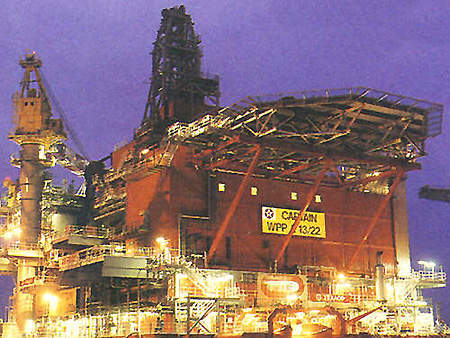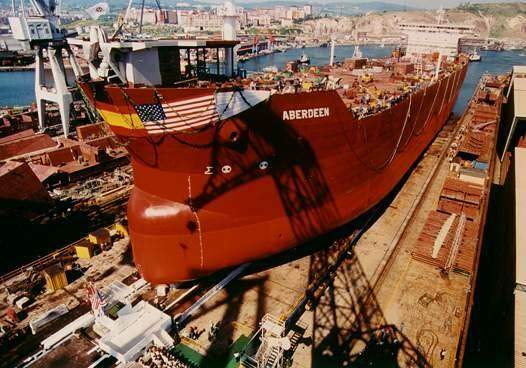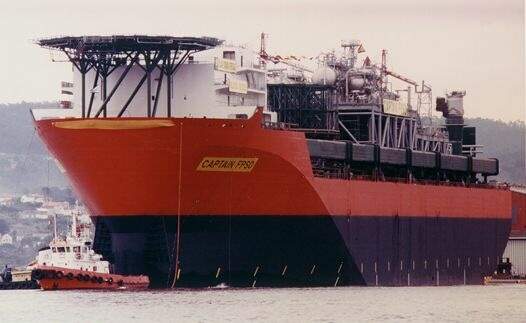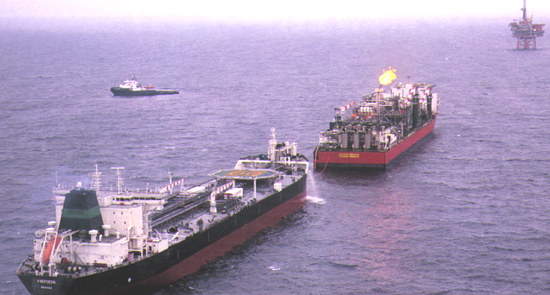Captain has undergone a huge Phase II expansion which has increased the 60,000 barrels per day rate to an average plateau rate of 85,000 barrels per day. A new platform was installed to develop the reservoir within the eastern part of the field (Area B). The $500 million Captain Expansion Project was completed within a 25-month schedule.
LOCATION
Captain is located 134km (90 miles) north-east of Aberdeen, in UK block 1 3/22a. It lies in a water depth of 104m (341ft). The Captain field is owned by Texaco North Sea UK Company (85%) and the Korea Captain Company Limited (15%). Production from Captain Area A came on-stream in March 1997
DRILLING
The Captain wells consist of horizontal sections 4,600-6,000ft long. In addition, because of the soft nature of the sand, these sections have to be supported by a 6,5/8in screen.
Area A contains 16 producers, five water injectors and one aquifer water-supply well. The Area B development was based on a 26-month drilling programme, begun in October 2000, including 14 long-reach horizontal wells and the first commercial deployment of gas-handling hydraulic submersible pumps, specially developed to handle the high gas content of the reservoir. Captain oil is viscous (19-21° API), with a low natural-gas content (85:130 gas/oil ratio).
INFRASTRUCTURE
The field infrastructure comprises a wellhead protector platform, which is connected by a network of pipelines to an FPSO, on which the crude oil is processed and stored. Oil from the field is exported by shuttle tanker, either directly to customers or to the Nigg Bay terminal in the Cromarty Firth. Storage in the terminal will enable a wide range of destinations and sizes of delivery, for worldwide distribution.
WELLHEAD PROTECTOR PLATFORM (WPP) – JACKET AND DECK
Built at UiE, Clydeside, the Captain’s jacket is a 4,500t structure, more than 400ft tall, measuring 110ft² at its base and 70ft² at the top.
FPSO
The floating production, storage and offloading vessel (FPSO) is based on a Tentech 700 design and it was built at Astano’s shipyard at El Ferrol, in Spain. The vessel is permanently stationed 1.5km from the WPP.
The vessel is 214.7m in length, 38m in breadth and 24m in depth. It has a displacement of 114,000t and a storage capacity of 550,000bbl. It can accommodate 50 people. The FPSO provides processing for the crude, the water for injection and has the ability to export the product to the shuttle tanker for transportation. It rotates around a central fixed point, the turret, through which the well fluids are brought onboard the vessel.
PIPE-LAY
The WPP and FPSO are connected by a series of pipelines (constructed from carbon steel and flexible pipe), which run along the seabed. Coflexip Stena Offshore supplied the pipelines.
The pipelines to the FPSO consist of a 16in production fluids line, a 10in well-test fluids line, a 14in water-injection line and a 3in polymer concentrate line. There is also an electrical power/communication line and a control umbilical.
AREA B EXPANSION
Texaco received consent from the UK Department of Trade and Industry (DTI) to expand the Captain. Area B is being developed subsea, utilising a single unitised 18-slot manifold connected via a suite of pipelines to a new process/utility platform, bridge linked to the existing Captain platform. The new platform comprises a 4,000t steel jacket, 5,500t topside and 75m bridge.
In November 1998, Texaco issued a contract, worth approximately £100 million, to Kvaerner Oil & Gas Limited for the detailed design, fabrication and installation of a bridge-linked platform for the Captain expansion project.
Kvaerner Oilfield Products was awarded the supply of a multiphase flowmeter,which was to be used in place of a test separator on the new bridge-link platform. The DUET (DUal Energy Transmission) multiphase meter’s non-intrusive, extremely accurate water-cut, oil and gas measurements will allow continuous well-testing, thereby aiding reservoir optimisation and increased oil recovery.
One of the key objectives of the Captain Expansion Project in the North Sea has been to further improve environmental performance. During the design stage of the project, an environmental assessment was carried out that identified design improvements that would allow environmental performance to be greatly enhanced.
Significant quantities of gas are expected for the first five years from the eastern area of the Captain field. As a result, the project has been designed to allow efficient use of gas.
Waste heat recovery units (WHRU) on the bridge-linked platform will generate heat for all requirements, instead of fired heaters. These WHRUs use hot exhaust gases from the platform’s turbines and redistribute the waste heat to production processes areas and the accommodation block.
These units will dramatically improve energy efficiency and consequent combustion emissions by reducing the demand for fuel. The use of WHRUs will result in a reduction of almost 900,000t of the greenhouse gas carbon dioxide.
The export pipeline will allow excess gas to be exported, reducing the requirement for flaring, further reducing greenhouse gas emissions by 1 million tonnes. Later in the life of the field, when the levels of gas decrease, quantities will be imported, minimising diesel use.
Captain has been designed as a zero discharge development. This is achieved by re-injecting produced water back into the reservoir. This avoids discharge of oil to sea and reduces energy requirements for pre-discharge cleaning.










